Optimal height in wattle fences balances functionality with structural integrity. You’ll need taller fences (4+ feet) for livestock containment, while shorter designs work better for gardens and aesthetics. Height directly impacts stability—taller structures require deeper post anchoring and thicker stakes to withstand environmental forces. For sloped terrain, you’ll want to adjust height proportionally to maintain erosion control. The ideal height also enhances visual appeal by maintaining golden ratio proportions with your surrounding landscape. Discover how the best height transforms your wattle fence from functional to exceptional.
Second-Level Headings for “Why Should Wattle Fences Have Optimal Height?”
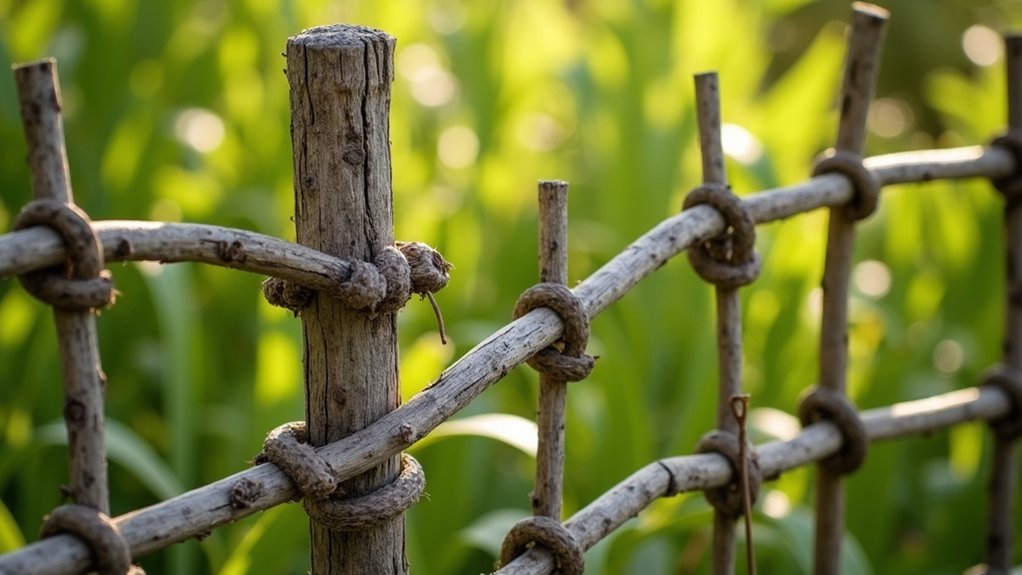
When planning your wattle fence project, understanding why ideal height matters can save you considerable time and resources.
Your fence’s optimal height directly impacts its structural stability, functional effectiveness, aesthetic appeal, and ecological benefits.
Consider organizing your article with these four key second-level headings:
- Structural Stability and Durability – Addressing how height affects strength, longevity, and resistance to environmental forces
- Functional Effectiveness for Intended Use – Explaining height requirements for different applications (livestock, gardens, windbreaks). The traditional wattle design offers sufficient height to effectively contain various animals including pets and livestock while providing them with outdoor freedom.
- Aesthetics and Landscape Integration – Exploring how height influences visual appeal and garden design
- Ecological and Wildlife Benefits – Discussing how proper height supports habitat creation and environmental harmony
These focused sections will help your readers understand the critical relationship between wattle fence height and successful implementation in their specific context.
Historical Height Standards in Traditional Wattle Fencing
Throughout centuries of rural craftsmanship, traditional wattle fencing rarely adhered to standardized height requirements, instead evolving organically to meet specific local needs.
You’ll find that height was primarily determined by practical purposes – shorter barriers kept rabbits from gardens, while taller structures prevented deer intrusion or contained livestock.
Material availability greatly influenced height decisions. Thicker stakes supported taller designs, while the flexibility of saplings allowed for varied heights based on necessity. The construction process typically requires a large supply of green saplings, with projects like a 200-foot fence needing around 850 pieces.
The humble craftsman’s choice was simple: robust timber for height, supple saplings for adaptability – nature dictating design.
European designs often featured woven hurdle panels that could be combined for different applications.
Construction techniques also played an essential role, with weaving methods affecting both stability and maximum achievable height.
Environmental factors like soil quality, prevailing winds, and local wildlife shaped these practical designs far more than formal regulations ever did.
The Golden Ratio of Fence Height to Garden Space
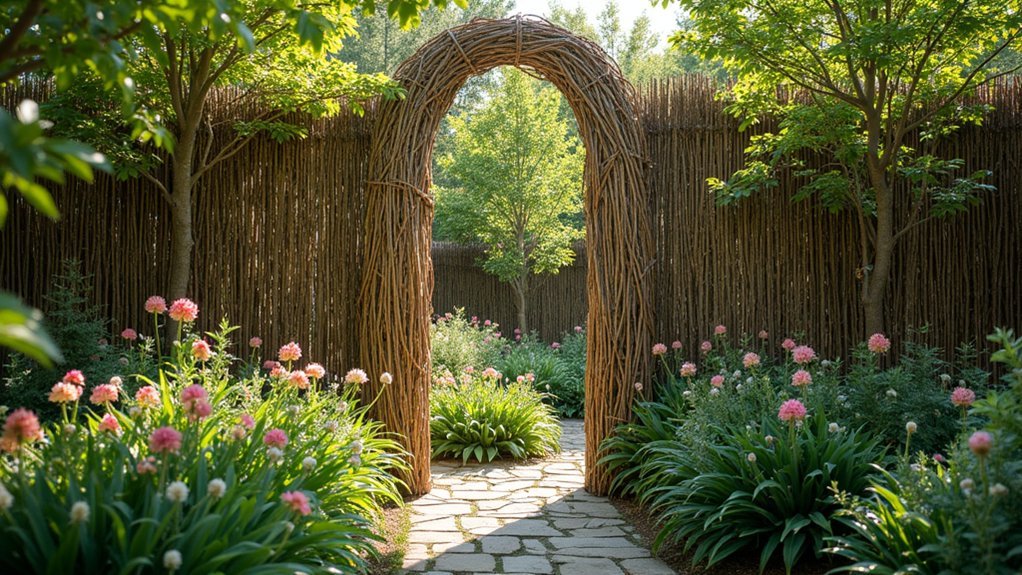
Using the golden ratio of 1:1.618 in your fence height planning creates visually pleasing proportions that will define your garden space with mathematical harmony.
You’ll achieve ideal spatial balance when your wattle fence height equals approximately one-third the length of your garden area, following the significant enclosure principle.
For a typical garden space of 9 meters in length, your wattle fence should ideally maintain a minimum height of 3 meters to create proper enclosure and refuge.
Apply Fibonacci patterns to your fence design by scaling elements proportionally—perhaps making your fence 1.6 times taller than your raised beds or matching its height to specific architectural features of your home.
Aesthetic Balance Principles
The golden ratio, approximately 1:1.618, serves as a fundamental principle for achieving aesthetic harmony in garden design, particularly when determining wattle fence heights.
When you apply this mathematical concept to your garden, you’re tapping into a natural order that feels inherently balanced to the human eye.
Consider using the golden rectangle principle to establish proportional relationships between your fence height and garden dimensions. This creates visual cohesion that connects all elements of your space.
Your wattle fence should never appear disconnected from surrounding features but instead act as a regulating line that organizes your garden harmoniously. Try creating groups of plant groupings in sizes of 3, 5, or 8 alongside your wattle fence to enhance the visual appeal of your garden space.
Space Definition Techniques
When you define spaces within your garden, the relationship between wattle fence height and garden dimensions becomes essential for achieving visual harmony. The golden ratio (1.618) provides a mathematical foundation for creating balanced proportions that feel naturally pleasing.
Consider these space definition techniques for ideal fence height:
- Apply the Law of Significant Enclosure to guarantee your fence height properly defines garden rooms without overwhelming them.
- Use regulating lines that connect your fence to other landscape elements, creating visual continuity.
- Incorporate Fibonacci numbers (3, 5, 8 feet) for fence dimensions that echo natural patterns.
- Balance perceived space by adjusting fence height to influence how open or intimate garden areas feel.
For optimal aesthetic appeal, introduce varying colors in your wattle fencing to create mood and feelings that complement your garden’s intended atmosphere.
Scaled Proportional Design
Achieving perfect balance between your wattle fence height and garden dimensions relies heavily on scaled proportional design principles, particularly the golden ratio of 1:1.618. This mathematical relationship creates visually pleasing proportions that feel naturally harmonious in your landscape.
When planning your wattle fence, consider how its height will relate to your garden’s width or length. A 3-foot fence might be ideal for a small herb garden, while a larger vegetable plot may benefit from a taller 4-foot boundary. Historically, these structures have been used for animal management in countryside farms, demonstrating their practical versatility beyond just aesthetics.
Remember that taller structures require deeper post anchoring for stability.
The materials you select—whether willow or hazel—affect both the fence’s perceived height and overall aesthetic. Choose locally sourced, flexible materials that complement your garden’s style while ensuring your fence remains proportionally balanced with surrounding features.
Seasonal Considerations for Wattle Fence Heights
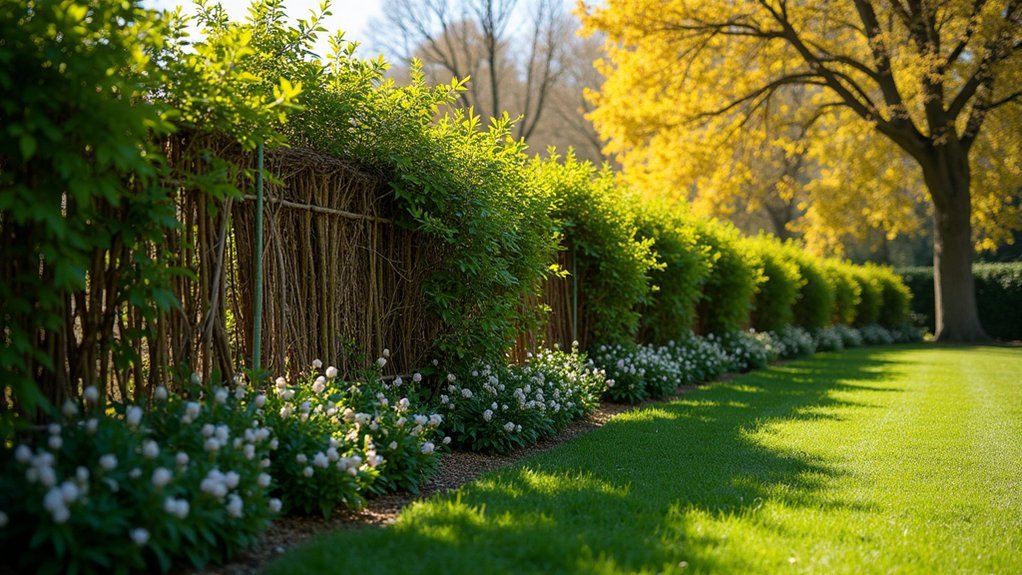
Selecting the ideal height for wattle fences requires careful consideration of seasonal factors that affect both construction and durability.
You’ll find that timing and environmental conditions greatly impact your fence’s longevity.
- Spring offers the most pliable branches, making it ideal for constructing fences of various heights, while late fall provides another excellent harvesting window.
- Taller fences face greater wind pressure and snow load challenges, so you’ll want lower structures in windy or snowy regions.
- Your maintenance requirements increase with fence height—taller structures demand more materials for repairs and create ladder-related safety concerns. Soaking dry willow branches overnight can significantly improve flexibility when maintaining or repairing taller sections.
- Building during drier seasons (late fall or early spring) provides better structural integrity and allows deeper post placement for taller designs.
Balancing Privacy With Natural Light Penetration
When planning your wattle fence height, you’ll need to balance the shade it creates with allowing sufficient light into your garden space.
You can incorporate strategic light corridors by varying the weaving density in certain sections of your fence, creating areas where more sunlight filters through.
Consider how the sun tracks across your property throughout the day to position these lighter-woven sections where they’ll maximize illumination without compromising privacy. The use of willow branches makes this variable density weaving possible, as they remain pliable after soaking while providing durability for garden structures.
Shade Versus Illumination
The delicate balance between privacy and natural light presents one of the most significant challenges when determining the ideal height for wattle fences.
You’ll need to take into account how much sunlight your garden requires versus your privacy needs.
When selecting the best height, remember:
- Taller fences (above 36 inches) provide more shade and privacy but may limit photosynthesis for nearby plants
- Adjusting weave density allows you to control light filtration—looser in winter for warmth, denser in summer for cooling shade
- Material thickness affects both privacy and light penetration—thicker branches block more light
- Strategic placement can help maintain soil moisture while accommodating the photoperiodic needs of your specific plants
Medieval gardens commonly used wattle fences to create enclosed spaces that offered both protection and aesthetic appeal.
Your choice ultimately impacts both plant health and your garden’s aesthetic appeal, making height assessment vital for success.
Strategic Light Corridors
Creating strategic light corridors through your wattle fence requires thoughtful design choices that balance seclusion with illumination needs.
Consider implementing an alternating weave thickness, which channels sunlight at different heights while maintaining privacy boundaries.
You’ll find that a fence between 3-4 feet tall offers an ideal compromise—tall enough to define your space yet short enough to allow ample daylight penetration.
If you need more privacy, opt for looser weaving patterns rather than increasing height, as this creates natural gaps for light passage.
Incorporate climbing plants strategically, avoiding dense foliage varieties that might block your carefully designed light paths.
For year-round effectiveness, account for seasonal sun angles when positioning your fence, ensuring winter sunlight can still reach indoor spaces when it’s most needed.
Including these design elements supports ecological health by creating partial shade zones that benefit sensitive plants while maintaining necessary sunlight for others.
Height Requirements for Different Livestock Species
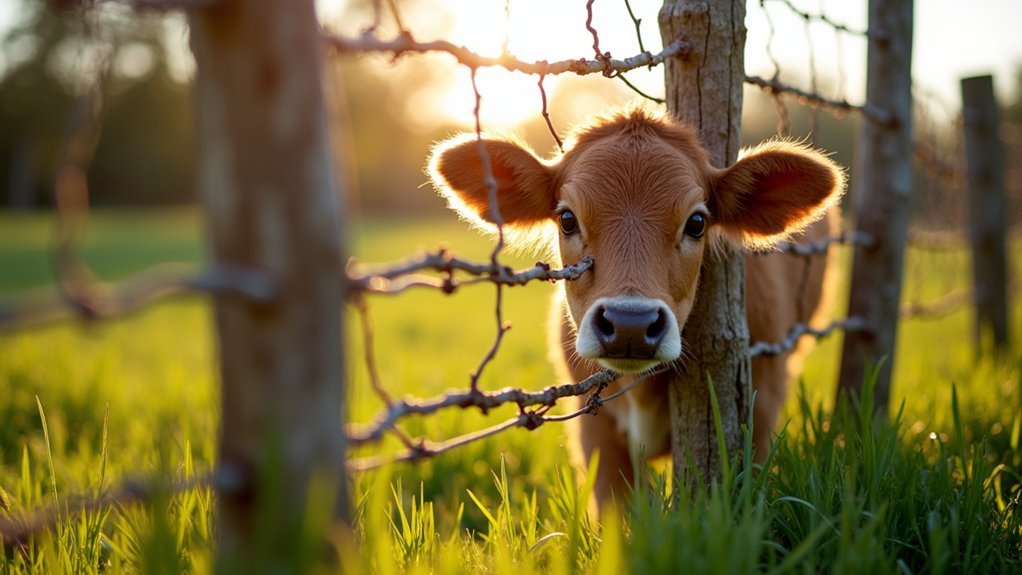
Different livestock species require varied wattle fence heights to guarantee proper containment while balancing material costs and construction effort.
When building your wattle fence, consider these species-specific guidelines:
- Goats and Sheep: Construct at least 4-foot base height with 3-foot vertical extensions (7 feet total) for goats. For sheep, 5-7 foot hurdles with thicker saplings (3+ inches) effectively resist rubbing.
- Chickens: A 4-foot base with 3-foot vertical twigs prevents most flyovers, though you’ll need denser upper weaving for heavier breeds. Creating a semi-circular design for your chicken pen makes the weaving process significantly easier and creates a more stable structure.
- Horses: Standard wattle heights often prove insufficient; commercial woven wire (48+ inches) remains safer and more effective.
- Pigs: Focus less on height and more on reinforcing the base against rooting, potentially pairing with electric wire.
The Impact of Local Climate on Ideal Fence Measurements
When constructing wattle fences, local climate conditions greatly influence your ideal height measurements and overall design choices. In windy areas, you’ll need taller fences to effectively block cold drafts, especially around vegetable gardens.
Consider your region’s moisture levels. Fences in wet climates typically last 10-15 years, compared to longer lifespans in drier locations. If you’re in a flood-prone area, build higher and reinforce the base. Incorporating flexible willow branches creates more resilient structures that can withstand environmental stresses.
Expect shorter fence lifespans in moisture-heavy regions—build accordingly with reinforced foundations in flood zones.
For clay-rich soils, you can achieve better stability with standard depths. Temperature extremes also matter. Strategic fence placement creates protective microclimates that extend growing seasons.
Choose locally available materials that resist your specific climate challenges—rot-resistant woods for humid regions, flexible materials for windy areas. Remember to inspect your fences seasonally, particularly after storms, to maintain their protective function.
Cultural Variations in Wattle Fence Design Heights
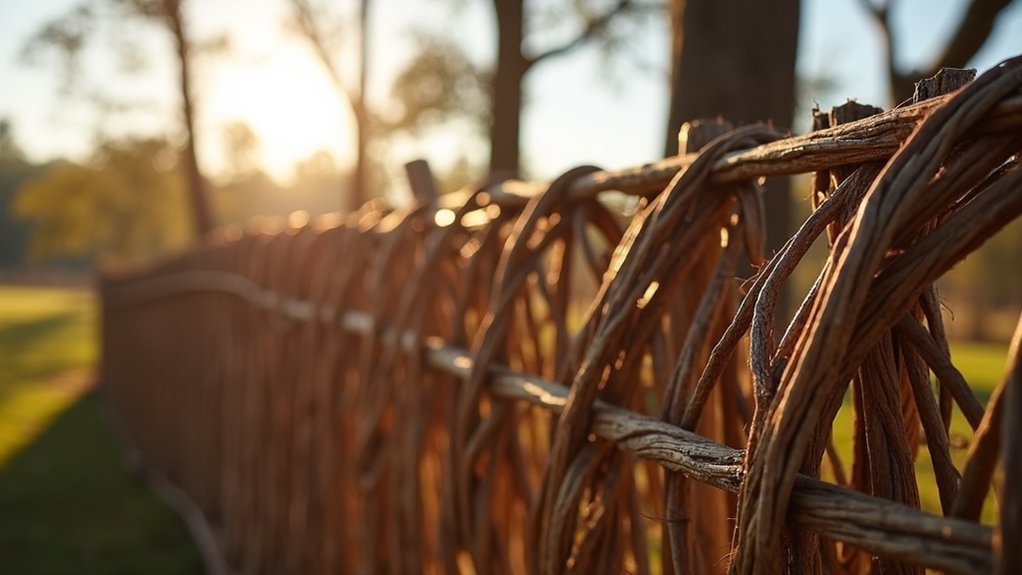
Cultural variations in wattle fence design heights reflect centuries of regional adaptation and social significance across civilizations.
You’ll find these differences rooted in both practical needs and social customs, with heights ranging from modest garden borders to impressive livestock barriers. Throughout history, wattle fencing has served to define property lines and create distinct boundaries within communities.
- Medieval English herb gardens featured wattle fences under eight feet, limited by available willow rod lengths but perfectly suited for plant support.
- Native American tribes optimized heights specifically for wind protection and animal deterrence, showing remarkable environmental adaptation.
- Colonial agricultural fences stood taller (4-6 feet) to contain livestock while maintaining visibility.
- European ornamental garden wattles remained lower (3-5 feet), blending functionality with aesthetic considerations.
The height you choose for your wattle fence should honor these traditions while meeting your specific needs and local environment.
Engineering Principles Behind Stable Wattle Heights
Underlying every stable wattle fence is a set of engineering principles that determine its ideal height and structural integrity.
You’ll need to balance several competing forces when deciding your fence height. The best height maintains load-bearing capacity while preventing collapse.
Remember this formula: post depth should equal 1/3–1/2 of your fence height—a 4ft fence needs 6ft posts with 2ft buried. For taller designs, you’ll require thicker uprights and possibly concrete reinforcement.
Height directly impacts wind resistance. Shorter fences (2–3ft) minimize wind shear, while taller structures need angled bracing. Ensure to drive stakes at regular intervals around the garden bed perimeter for proper support and stability.
Your material choice matters too; branches maintain tensile strength for fences up to 4ft without sagging, but taller designs risk weave gaps and reduced stability as the center-of-mass rises.
Adapting Fence Height for Sloped Terrain
When installing wattle fences on slopes, you’ll need to increase height proportionally with the gradient to maintain effective erosion control.
You can choose between stepped installation for terraced terrain or angled placement that follows the natural contour, depending on your specific erosion concerns.
Your support requirements will vary dramatically based on terrain characteristics, requiring more stakes on steeper slopes and additional reinforcement where water channels naturally form. For optimal results, consider using our erosion control blankets in conjunction with wattle fences to provide comprehensive protection for vulnerable landscapes.
Gradient-Responsive Height Adjustments
Adapting wattle fence heights for sloped terrain requires careful calculation of gradient forces that directly impact structural integrity.
When working with slopes exceeding 33%, you’ll need shorter fences to prevent soil pressure overload and reduce lateral forces on your woven branches.
- For steep gradients, follow the 1,000/slope gradient rule to determine spacing that complements your reduced height.
- On loamy soils, implement lower fence heights with tighter spacing to counter erosion vulnerability.
- Use 24″ stakes in soft soils to maintain stability while reducing overall fence height.
- Align fence heights with contour lines to manage water runoff without creating destructive backflow.
Remember that taller fences on steep slopes obstruct water flow and increase hydrostatic pressure, potentially leading to premature structural failure during soil saturation events.
Stepped vs. Angled Installation
The decision between stepped and angled wattle fence installation greatly impacts both performance and longevity on sloped terrain.
When you’re working with moderate to steep slopes, stepped installations offer superior erosion control by directing water sideways rather than allowing vertical runoff. Though more complex to construct, these stepped patterns distribute soil pressure more evenly and prevent major slope failures.
For gentler gradients, angled installations provide a practical alternative. You’ll find them simpler to build while still creating a continuous barrier against erosion. They’re more material-efficient but require proper anchoring to maintain structural integrity.
Your choice should depend on your slope’s gradient, soil type, and available resources.
Whichever method you select, make sure you’ve adapted the height properly to integrate with the terrain’s natural contours.
Terrain-Based Support Requirements
Your wattle fence’s height must be strategically adapted to match the terrain’s unique contours, especially on challenging slopes. When installing on gradients, consider how different soil types affect stability and erosion control effectiveness.
For ideal slope installation:
- Adjust vertical spacing based on gradient steepness—closer spacing for steeper slopes provides better erosion control.
- Select appropriate stake length and material (wood stakes offer biodegradability while maintaining necessary support).
- Incorporate trenching depths that correspond to soil conditions—deeper for soft soils, shallower for hard terrain.
- Add kickboards or reinforcement at the fence base when functioning as a retaining wall on steep inclines.
Remember that properly aligned wattle fences can serve as effective retaining structures when anchored correctly, holding back soil while maintaining their structural integrity against the natural forces of sloped terrain.
Complementing Architectural Elements Through Strategic Heights
When selecting the ideal height for wattle fences, you’ll need to take into account how they’ll interact with existing architectural elements in your landscape. The height should maintain scale and proportion relative to surrounding structures, creating visual balance rather than competition.
For modern settings, you can adjust heights to complement contemporary design elements while preserving functionality. In historically themed gardens, match traditional fence heights to maintain authenticity.
Remember that your fence height impacts more than just aesthetics—it affects sunlight distribution, shadow patterns, and the overall flow of your outdoor space.
Always verify that your chosen height complies with local building codes and zoning laws. The right height choice creates harmony between your fence and architectural features while serving practical needs like privacy and security.
Material Selection Based on Desired Fence Height
As we shift our focus from architectural integration to the materials themselves, proper selection becomes a foundational aspect of successful wattle fence construction. Your fence’s height directly dictates the materials you’ll need for stability and longevity.
For taller fences, you’ll need:
- Thicker branches (3-4 inch diameter posts) set deeper into the ground
- Closer stake spacing to maintain structural integrity
- Flexible yet durable materials like hazel or willow for effective weaving
- Reinforced corners with additional stakes or thicker branches
Remember that soil conditions impact your material choices too. Sandy soil requires deeper post placement, while clay may provide more natural support.
While thicker materials might increase your initial costs, they’ll provide the necessary support for taller structures and reduce maintenance over time.
Frequently Asked Questions
Can Wattle Fence Height Affect Property Value or Neighborhood Appeal?
Yes, your wattle fence’s height affects property value and neighborhood appeal. When it’s ideally sized, it enhances curb appeal, maintains community aesthetics, and balances privacy needs without obstructing views or violating local regulations.
How Does Fence Height Influence Sound Dampening in Urban Gardens?
Your fence’s height directly impacts sound dampening. You’ll need at least 8 feet for traffic noise reduction, with each additional foot providing about 0.5 dB improvement. Taller barriers also help mitigate low-frequency sounds effectively.
Are There Legal Height Restrictions for Wattle Fences in Residential Areas?
Yes, wattle fences face the same legal height restrictions as other fences in your area. In Massachusetts, you’ll typically find a 6-foot limit for backyards and 3-foot limit for front yards.
Can Optimal Fence Height Reduce the Risk of Frost Damage?
Yes, you’ll reduce frost damage with ideal fence height. Lower fences minimize water accumulation that freezes, while proper design prevents ice caps from forming and reduces expansion stress on the woven materials.
Do Different Weaving Patterns Require Specific Heights for Structural Integrity?
Yes, different weaving patterns do require specific heights for structural integrity. You’ll find that tighter weaves need appropriate height ratios to maintain tension, while looser patterns require taller structures to guarantee stability throughout.
In Summary
When you establish the ideal height for your wattle fence, you’re creating more than just a boundary—you’re crafting a harmonious element that enhances your garden aesthetically and functionally. Consider your specific needs, terrain challenges, and seasonal light patterns. Remember, the best height strikes a perfect balance between privacy, stability, and visual appeal while honoring traditional craftsmanship. Your thoughtfully proportioned wattle fence will serve you beautifully for years to come.

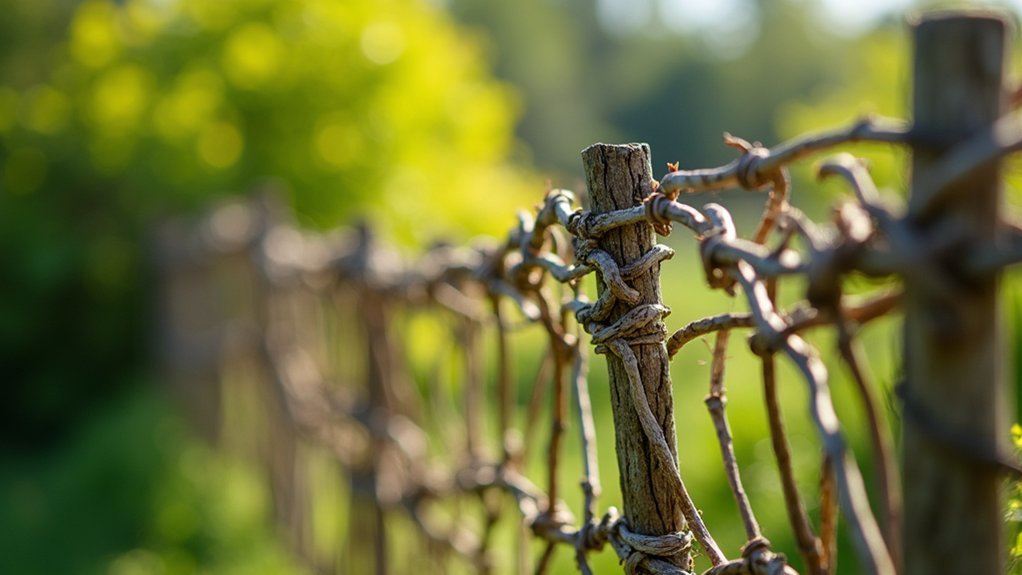



Leave a Reply